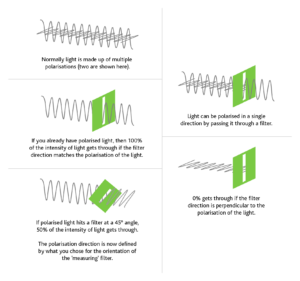Polarisation is a fascinating property of the electromagnetic spectrum. Let us take a whistle-stop tour of how polarisation is used in nature, some existing technologies that rely upon it, and how it may play a significant part in creating a guaranteed-private internet, secured by the laws of physics.
Unsurprisingly, we humans look at the world around us with our peculiar human vision, and sometimes this limits our view of the world. Whilst it would be reasonable to assume that other creatures see the world in a similar way, this is not true. Indeed, our use of the phrase ‘visible light’, is also human-focussed; many animals’ eyes do not respond to the same part of the electromagnetic spectrum as human eyes do. Human eyes cover the portion 380 to 700 nanometers, using three types of cone with peak sensitivities corresponding to red, green and blue (unless you are colour-blind or perhaps even a tetrachromat). Some animals are sensitive to UV or infra-red, and many creatures have fewer or more than three types of colour-sensing cones. Some butterflies and mantis shrimps can detect up to 12 distinct wavelengths.
There is also other information in the light all around us that is invisible to humans; which is that light can be polarised. Whilst our human eyes may be incapable, some creatures have evolved eyes that can detect the difference between light rays polarised along different axes. The reason zebras (and other animals) have stripes may be to reduce attacks from biting flies that can sense this polarisation.
In 1932, Dr Edwin Land produced the world’s first commercially available polarising filter, which he called the Polaroid. Since then, polarising filters have become relatively common place, with sunglasses and camera lenses using them to reduce reflections. 3D films send selective images to each eye using differently polarised lenses, and a liquid crystal display (LCD) uses liquid crystal molecules between two polarising sheets – the molecules align themselves when an electric current passes between them, causing some frequencies of light to become blocked.
Understanding polarisation
To understand what polarisation is, we must first be comfortable with the idea that light is part of the electromagnetic spectrum, which travels as transverse waves. These waves are made up of electric fields and magnetic fields, oscillating in phase at 90° to each other. When we are drawing polarised light, to simplify the picture, we normally only draw the oscillating electric field.
Light, as created by the sun or by a normal light bulb, will be unpolarised: that is, all the rays of light will be polarised along different axes. However, light can be polarised (or partially polarised) when it reflects off a reflective surface, at a shallow angle.
We can also polarise light by passing it through a polarising filter. By passing unpolarised light through a polarising filter half of the light will be absorbed by the filter, but the half that gets through will now be polarised to match that filter.

Polarisation in nature
Being able to sense the polarisation of light is surprisingly common in the animal kingdom. We know it is used by many arthropods (spiders, insects, crustaceans) and also cephalopods (squid, octopi) – where it is thought it may be used to improve vision in the absence of colour.
Bees are excellent navigators, and it is thought that their sensitivity to polarisation may play a significant factor. Whilst the light that comes from the sun is unpolarised, as it hits our atmosphere it is scattered (causing light to appear to come from everywhere in the sky, not just from the sun). As it is scattered, a portion of the light becomes polarised. Whilst the polarising effect in the atmosphere is small, it does mean that when we study a cloudless sky, the light will be slightly polarised in circles around the sun. This means that even if a bee can only see a tiny portion of a cloudless sky, it will still know what the direction of the sun is – therefore helping it to navigate, giving a polarising-sensitive bee a selective advantage.
Another example of polarisation in nature is when looking at the stripes of a zebra. Studies have shown that zebras are attacked less by tabanids (a biting horse-fly) than equivalent horses that are a solid colour, whether those horses were black, white, brown or grey. This is attributed to the coloured stripes on a zebra causing partial polarisation of the light in alternating directions, which can be viewed by camera using different filters. The studies demonstrate that putting alternating polarising stripes on a grey surface reduces the number of tabanids attracted, even though it would appear to a human as a totally homogenous, grey surface. They were also able to show that having these lines too close or too far apart reduced the effectiveness of this protection.
If the zebra did not deter the tabanid flies, it could have a negative consequence on its ability to survive and successfully reproduce, as the tabanids can be vectors of several pathogens, and when irritated the animals’ grazing can reduce, decreasing both milk production and body mass.
Therefore, it is believed that polarising stripes have provided a selective advantage to zebras.
Discover more in The Peculiar Powers of Polarisation – in maths and in the quantum realm, where we look at its use in technology and the mathematics involved.
Download PDF
If you wish to save, or print, this article please use this pdf version »


